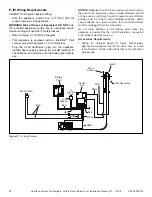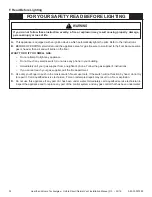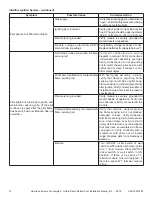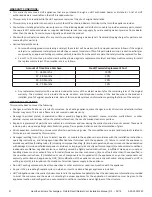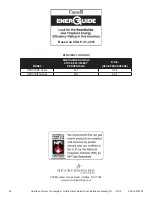
41
41
3-90-30007480
Hearth and Home Technolgies • Oxford Direct/Natural Vent Installation Manual_R3 • 02/19
I. Maintenance Frequency
Venting
Frequency:
Seasonally
By:
Homeowner
Tools needed:
Protective gloves and safety glasses.
• Inspect venting and termination cap for blockage or
obstruction such plants, bird nests, leaves, snow, debris,
etc.
• Verify termination cap clearance to subsequent
construction (building additions, decks, fences, or
sheds).
• Inspect for corrosion or separation.
• Verify weather stripping, sealing and flashing remains
intact.
• Inspect draft shield to verify it is not damaged or missing.
Maintenance Tasks-Service Technician
The following tasks must be performed by a qualified
technician.
Gasket Seal and Glass Assembly Inspection
Frequency:
Annually
By:
Service Technician
Tools needed:
Protective gloves, drop cloth and a stable
work surface.
• Inspect gasket seal and its condition.
• Inspect fixed glass assembly for scratches and nicks that
can lead to breakage when exposed to heat.
• Confirm there is no damage to glass or glass frame.
Replace as necessary.
• Verify that fixed glass assembly is properly retained and
attachment components are intact and not damaged.
Replace as necessary.
Logs
Frequency:
Annually
By:
Service Technician
Tools needed:
Protective gloves.
• Inspect for damaged or missing logs. Replace as
necessary.
• Verify correct log placement and no flame impingement
causing sooting. Correct as necessary.
Burner Ignition and Operation
Frequency:
Annually
By:
Service Technician
Tools needed:
Protective gloves, vacuum cleaner, whisk
broom, flashlight, voltmeter, indexed drill bit set, and a
manometer.
• Verify burner is properly secured and aligned with pilot or
igniter.
• Clean off burner top.
• Verify batteries have been removed from battery back-
up IPI systems to prevent premature battery failure or
leaking.
• Check for smooth lighting and ignition carryover to all
ports. Verify that there is no ignition delay.
• Inspect for lifting or other flame problems.
• Verify air shutter setting is correct. See Section
“4-F
Burner Information”
for required air shutter setting. Verify
air shutter is clear of dust and debris.
• Inspect orifice for soot, dirt and corrosion. Verify orifice
size is correct. See Service Parts List for proper orifice
sizing.
• Verify manifold and inlet pressures. Adjust regulator as
required.
• Inspect pilot flame pattern and strength. See Figure 7.3
for proper pilot flame pattern. Clean or replace orifice
spud as necessary.
• Inspect IPI flame sensing rod for soot, corrosion and
deterioration. Polish with fine steel wool or replace as
required.
• Verify IPI millivolt output. Replace as necessary.



